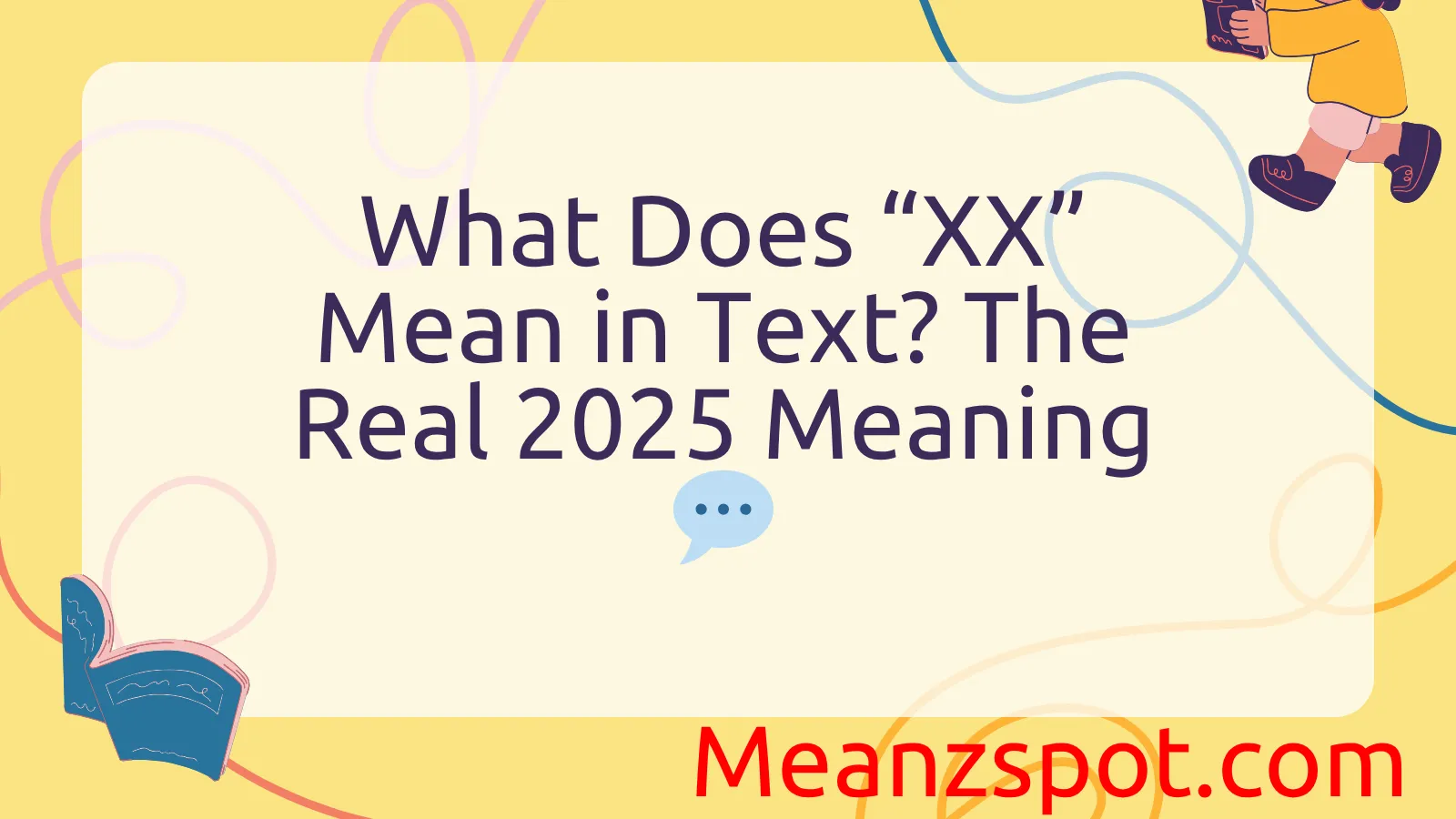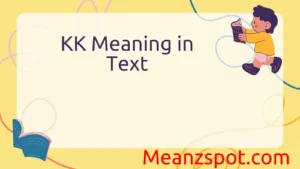Ever seen someone end a text with “XX” and wondered what it really means? 💬 You’re not alone! In today’s world of fast texting, emojis, and online slang, “XX” has become one of those little symbols that can say a lot without using words. From sweet messages between couples to friendly sign-offs, “XX” usually stands for kisses, showing affection, care, or warmth — but context matters! 😘
In 2025, its meaning has evolved beyond romance. You might see “XX” used by friends, influencers, or even co-workers as a casual, light-hearted way to end a chat. It’s all about the tone, relationship, and setting. So whether you got “XX” from your crush, your best friend, or a random text, we’re here to decode what it truly means in every situation — with real examples, modern usage, and tips so you never misread the message again. 💌
Definitions & Meaning
At its core, “XX” is a symbolic representation of kisses, most commonly used in written communication like text messages, emails, and direct messages. It stems from the tradition of using the letter “X” to represent a kiss. When you see one “X,” it typically means a single kiss. Add another, and “XX” means two kisses — often used to show affection, warmth, or friendliness.
For example:
- “Goodnight! Talk tomorrow xx”
- “Thanks so much for your help xx”
In casual texting, “XX” is usually friendly and informal. It doesn’t always indicate romantic interest; rather, it often conveys affectionate regard, much like a hug or warm handshake might in person.
However, the meaning can vary depending on context, tone, and the relationship between sender and receiver. For instance, receiving “XX” from a friend is perfectly normal. But if it’s from a colleague, it might raise eyebrows unless there’s an established rapport.
Origins & History
The use of “X” as a symbol for a kiss dates back centuries, long before digital communication. Its earliest known use is rooted in medieval times, when people who couldn’t read or write would sign documents with an “X” and then kiss it to show sincerity. Over time, that gesture evolved into a symbol of love, affection, and trust.
As letter writing became more common, especially among lovers or close friends, the “X” gradually turned into a sign-off for kisses. With the advent of digital communication in the late 20th and early 21st centuries, it found a new home in emails, text messages, and social media.
The double “XX” became popular in British and Australian cultures as a casual, affectionate sign-off, sometimes even used between strangers or acquaintances. Its usage spread internationally thanks to messaging apps and global pop culture.
So while “XX” may feel modern, it’s actually a centuries-old practice adapted for the digital age.
Usage in Different Contexts
“XX” can mean slightly different things depending on where and how it’s used. Here’s a breakdown of its usage across various contexts:
1. Social Media & Text Messaging
In personal messages, “XX” is often dropped at the end of a text to add a sense of warmth and friendliness. It’s especially common among women, though not exclusively.
Examples:
- “See you tomorrow! xx”
- “Happy birthday! Hope you have the best day xx”
On platforms like WhatsApp, Instagram, or Facebook Messenger, using “XX” is considered normal in friendly chats. Emojis like ❤️ or 😘 often accompany it to enhance the affectionate tone.
2. Professional Settings
Using “XX” in work-related messages is less common and can be risky, depending on the formality of the relationship. In more casual industries — like fashion, media, or entertainment — colleagues might exchange “XX” if there’s mutual familiarity.
However, in corporate or international business contexts, it’s best avoided as it can be misinterpreted as unprofessional or overly personal.
3. Pop Culture
TV shows, music, and celebrity culture have normalized affectionate shorthand like “XX.” British reality shows like Love Island or The Only Way Is Essex often feature characters using “XX” in texts and voiceovers. It adds a relatable and friendly flair.
4. Romantic Relationships
In dating conversations, “XX” can carry a more intimate meaning, especially when paired with other signs of affection. However, even here, it’s not always romantic — context is key.
Common Misunderstandings & Clarifications
Despite its widespread use, “XX” is often misunderstood. Here are a few clarifications:
- It’s not always romantic. Many assume “XX” signals romantic intent, but it’s commonly used between friends, family, or even polite acquaintances.
- It’s not gender-specific. While women tend to use it more frequently, men also use “XX” in casual, friendly messages, especially in cultures where it’s a norm.
- Tone matters. If the message is formal or strictly business-related, adding “XX” might feel out of place. But in friendly or familiar interactions, it can feel warm and natural.
- It doesn’t always need a reply in kind. If someone signs off with “XX,” you don’t have to reply with it unless you feel comfortable. Some people prefer to keep messages less emotionally loaded.
Alternatives & Synonyms
If “XX” doesn’t feel right for your tone or situation, here are some alternatives you can use depending on the level of formality or emotion:
| Expression | Meaning | Context |
|---|---|---|
| X | One kiss | Very casual, less affectionate |
| XXX | Three kisses | Often playful or flirtatious |
| ❤️ | Love/affection | Can be romantic or platonic |
| 😘 | Blowing a kiss | Friendly, flirtatious, or loving |
| Hugs | Warmth and comfort | Neutral, good alternative |
| Cheers | Friendly sign-off | Common in UK, less emotional |
| Take care | Polite closure | Safe and professional |
These alternatives let you tailor your sign-off based on your relationship with the recipient and the tone you want to convey.
Frequently Asked Questions (FAQ)
1. Is “XX” always flirty or romantic?
No. “XX” often simply shows friendliness or affection. Context and relationship matter more than the symbol itself.
2. Should I use “XX” in work emails?
Not usually. It can seem unprofessional unless you’re in a relaxed industry or have an established rapport.
3. What’s the difference between “X” and “XX”?
“X” typically represents a single kiss, while “XX” means two kisses — a touch more affectionate or familiar.
4. Why do people from the UK use “XX” so much?
In British culture, “XX” is a very common and casual way to end messages warmly, even among acquaintances.
5. Is it rude not to respond with “XX”?
Not at all. It’s optional. If it feels natural to you, reply in kind. If not, a friendly emoji or polite sign-off works just as well.
6. Can men use “XX” in messages?
Absolutely. There’s no gender rule for using or receiving “XX.” It’s all about the tone and context.
7. What if I get “XX” from someone I barely know?
They may just be friendly or following cultural texting norms. Don’t read too much into it unless paired with other signs of intent.
Conclusion
“XX” may look like just two letters, but it packs a lot of subtle meaning depending on how, when, and where it’s used. Originally a centuries-old symbol for sincerity and affection, it’s evolved into a modern shorthand for warmth in digital communication. Whether it shows up in a friend’s message, a co-worker’s DM, or a social media post, it typically signals friendliness — not necessarily flirtation or formality.
Understanding the context and cultural norms behind “XX” helps you respond appropriately and avoid awkward misunderstandings. Whether you use it or not, recognizing its meaning adds a valuable layer of emotional intelligence to your digital conversations.



